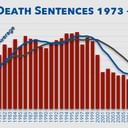New York Times
By LINDA GREENHOUSE
WASHINGTON, Jan. 11 — The Supreme Court agreed today to decide a potentially far-reaching challenge to the constitutionality of the death penalty laws in nine states where judges rather than juries determine whether to sentence a killer to death.
Close to 800 death sentences in those states could be in question, depending on the breadth and retroactivity of a final ruling. The case is from Arizona, where 128 people are on death row, and the court’s decision will also apply to these states with similar laws: Florida, which has 385 inmates on death row, along with Alabama, Colorado, Delaware, Idaho, Indiana, Montana and Nebraska.
In those states, juries decide if a defendant is guilty and then a judge makes the crucial finding of whether a murder was committed with aggravating circumstances that warrant a sentence of death. In the 29 other states that have the death penalty, as well as in the federal system, juries determine whether aggravating circumstances exist and weigh those against any mitigating circumstances.
In accepting an appeal from an Arizona death row inmate, Timothy S. Ring, convicted in 1994 of the murder of an armored truck driver during a robbery, the court significantly expanded its re-examination of the respective roles of judges and juries in criminal sentencing.
The new case is a logical if not inevitable outgrowth of the court’s ruling in Apprendi v. New Jersey, in June 2000, which invalidated New Jersey’s hate-crime law on the ground that it called upon the judge to make the central finding of motive that converted an ordinary crime into a hate crime that carried a longer sentence. Under the constitutional guarantees of due process and trial by jury, the court said, such a finding must be made by a jury beyond a reasonable doubt.
The Apprendi decision jolted the criminal justice system, calling into question a common approach to sentencing. Before granting the case today, Ring v. Arizona, No. 01 – 488, the court had already agreed to hear two Apprendi-related cases in the current term.
In one, Harris v. United States, No. 00 – 10666, the question is whether a fact that increases a mandatory minimum sentence — in this instance, whether a defendant was “brandishing” rather than just carrying a gun — must be found by the jury rather than the judge. The other case, United States v. Cotton, No. 01- 687, raises the question of whether certain federal sentences imposed before the Apprendi decision warrant automatic reversal because they violated its requirement that factors that could increase a sentence must be charged in the indictment.
Although the most immediate impact of the Cotton decision will be on federal drug cases, in which the precise quantity of drugs was not charged in the indictment before the Apprendi decision, it could also have implications for the majority of death penalty states where juries make the finding of aggravating circumstances. In those states, as well as under the federal death penalty law, the potential aggravating factors — like an especially heinous and cruel murder, or one committed for financial gain — are not charged in the indictment but are left for a separate sentencing hearing after conviction.
The host of questions raised by the Apprendi decision that are now reaching the court underscores Justice Sandra Day O’Connor’s warning in her dissenting opinion in that case that its implications “could be colossal.”
The Harris case will be argued in March, with the Cotton case and the new case to be argued in April. The justices accepted four new cases today, filling out the remainder of the decision calendar for the current term.
The court is now scheduled to issue a total of 76 decisions for the term. There is one potential addition, a challenge by Utah to the method used in the 2000 census to ascribe a number of residents to addresses at which no one could be contacted. The justices will consider later this month whether to hear that case, Utah v. Evans, No. 01 – 714.
In the Apprendi case, which was decided by a 5‑to‑4 vote, the majority said that the principle it was establishing did not apply to capital cases, an exception that was necessary to preserve a 1990 precedent, Walton v. Arizona, which had upheld Arizona’s death penalty law. In her dissenting opinion, Justice O’Connor said the distinction was “baffling, to say the least,” and many people have assumed it was only a matter of time before the court would be forced to confront the issue.
The Arizona Supreme Court has turned down several appeals from death row inmates on the ground that it remained bound by the Walton decision as long as the precedent remained on the books. Lawyers for another inmate, James C. Harrod, whose case the justices considered today along with the Ring case, said the Arizona courts were “in turmoil” over the issue.
Lawyers for Mr. Ring called the Apprendi and Walton decisions “fundamentally irreconcilable” and told the justices that all death sentences issued in the nine affected states “will be under a heavy cloud of constitutional doubt” until the Supreme Court resolved the question.
After Mr. Ring was convicted of murder, the jury was discharged and the judge went on to find two aggravating circumstances: that the murder was committed for financial gain and that it was committed in an especially heinous or depraved manner. These findings made Mr. Ring eligible for the death penalty, which the judge then imposed.
The Arizona attorney general, Janet Napolitano, told the justices that there was no need to take the case. She said it was a misunderstanding of Arizona law to describe the judge’s role as increasing the possible sentence from life to death. Because murder is a capital offense in Arizona, she said, “a death sentence does not extend the range of sentencing” and consequently does not pose a problem under Apprendi.
In a second case today, the court agreed to decide whether Congress intended to permit individual lawsuits to enforce a 1974 law that protects the privacy of students’ educational records. Commonly known as the Buckley amendment, the law is the Family Educational Rights and Privacy Act.
In this case, Gonzaga University v. Doe, No. 01 – 679, a student teacher alleged that his rights under the law were violated when faculty members at Gonzaga, the Jesuit university in Spokane, Wash., discussed with a state investigator a student’s accusation that he sexually assaulted her.
Gonzaga argued that the law provided only for the withdrawal of federal financial assistance from an educational institution and did not permit private suits for damages. The Washington Supreme Court held that rights under the law were individually enforceable in court.
The question of the private enforceability of the Buckley amendment is also at issue in another case now before the court. In Owasso Independent School District v. Falvo, No. 00 – 1073, an Oklahoma school district is appealing a decision that it violated the law by having students review each other’s papers and tests and call out the grades in class.
When the case was argued in November, the justices were concerned whether the suit, brought by a parent, should have been permitted, but the school district itself had not raised that issue. If the court decides in the new case that there was no private right to sue, it will probably vacate the Owasso decision without deciding the merits of the in-class grading question.



